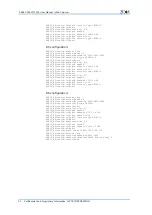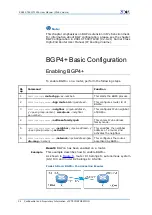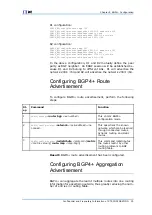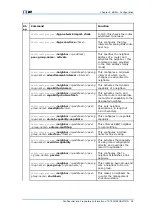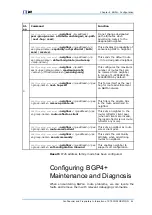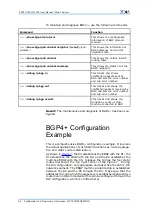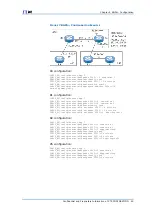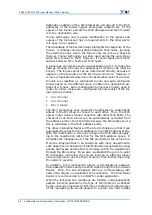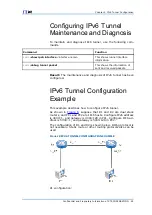
ZXR10 T600/T1200 User Manual (IPv6 Volume)
destination address of the IPv4 datagram correspond to the IPv4
addresses of the tunnel ingress and egress respectively. At the
egress of the tunnel, extract the IPv6 datagram and then forward
it to the destination site.
Tunnel technology only requires modification to the ingress and
egress of the tunnel and has no requirements to the other parts;
it is easy to be realized.
The advantage of tunnel technology highlights transparency of the
tunnel. It enables communications between IPv6 hosts, ignoring
the existing tunnel, where the tunnel only servers as a physical
channel. Tunnel technology is widely used during the early stage
when IPv4 evolves to IPv6. However, it cannot realize communi-
cations between IPv4 hosts and IPv6 hosts.
A tunnel has an ingress point and a destination point. To make the
data go through a tunnel, the addresses of its two ends must be
known. The ingress point can be determined directly, because it
appears on the boundary of the IPv4 basic structure. However, it
is more complicated to determine the destination point of a tunnel.
Tunnels are classified as configured tunnel and auto-configured
tunnel based on the different ways to obtain the destination ad-
dress of a tunnel. Auto-configuration tunnels are mainly used in
router-to-router, while auto—configured tunnels consist of the fol-
lowing three modes:
�
6 in 4 tunnel
�
4 in 6 tunnel
�
6 to 4 tunnel
The 6to4 technology uses special IPv6 addresses to enable IPv6
islands in the IPv4 sea to connect to each other. Then, the IPv6
egress router creates tunnel connection with other IPv6 fields. The
end point of an IPv4 tunnel can be automatically extracted from
the address prefix of an IPv6 field, because the IPv4 address of a
site is contained in the IPv6 address prefix.
The other interesting feature of the 6to4 technology is that it can
automatically extract an IPv4 address from an IPv6 address prefix.
With this mechanism, a site can configure the IPv6 without apply-
ing to the registration institution for the IPv6 address space. It
simplifies the management of the ISP providers at the same time.
It can be imagined that in an enterprise with many departments,
each department can build a virtual IPv6 external network by using
private addresses and the NAT technology within the department
through the 6to4 policy. It can also re-establish the point-to-point
IP connection, and allow the servers locating on different places
of an enterprise to use the IPsec protocol, thus further improving
the network security.
In addition, 6to4 mechanism allows communications between
6to4-based IPv6 sites and pure IPv6 sites through the 6to4 Relay
Router.
Then, the two endpoints that are communicating with
each other require no available IPv4 connection. The 6to4 Relay
Router is recommended to run BGP for wider application.
When the following two conditions are fulfilled, encapsulate IPv6
packets into IPv4 packets by the Type 41 IPv4 protocol, as defined
by the conversion mechanism RFC. One condition is the 6to4 router
of the requesting site sends packets to another site that resides
66
Confidential and Proprietary Information of ZTE CORPORATION
Summary of Contents for ZXR10 T1200
Page 5: ...Figures 71 Tables 73 List of Glossary 75 ...
Page 6: ......

